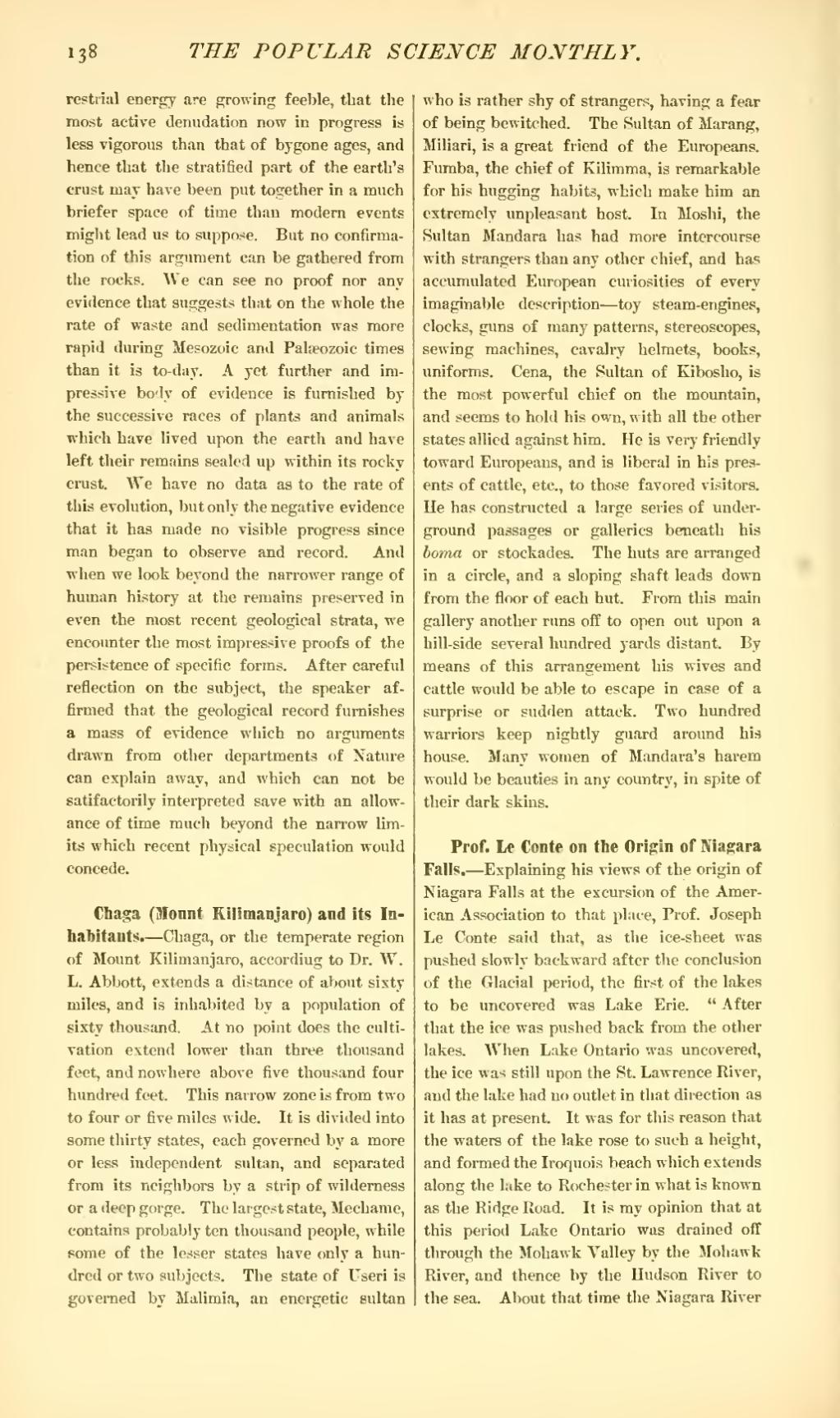restrial energy are growing feeble, that the most active denudation now in progress is less vigorous than that of bygone ages, and hence that the stratified part of the earth's crust may have been put together in a much briefer space of time than modern events might lead us to suppose. But no confirmation of this argument can be gathered from the rocks. We can see no proof nor any evidence that suggests that on the whole the rate of waste and sedimentation was more rapid during Mesozoic and Palæozoic times than it is to-day. A yet further and impressive body of evidence is furnished by the successive races of plants and animals which have lived upon the earth and have left their remains sealed up within its rocky crust. We have no data as to the rate of this evolution, but only the negative evidence that it has made no visible progress since man began to observe and record. And when we look beyond the narrower range of human history at the remains preserved in even the most recent geological strata, we encounter the most impressive proofs of the persistence of specific forms. After careful reflection on the subject, the speaker affirmed that the geological record furnishes a mass of evidence which no arguments drawn from other departments of Nature can explain away, and which can not be satifactorily interpreted save with an allowance of time much beyond the narrow limits which recent physical speculation would concede.
Chaga (Mount Kilimanjaro) and its Inhabitants.—Chaga, or the temperate region of Mount Kilimanjaro, according to Dr. W. L. Abbott, extends a distance of about sixty miles, and is inhabited by a population of sixty thousand. At no point does the cultivation extend lower than three thousand feet, and nowhere above five thousand four hundred feet. This narrow zone is from two to four or five miles wide. It is divided into some thirty states, each governed by a more or less independent sultan, and separated from its neighbors by a strip of wilderness or a deep gorge. The largest state, Mechame, contains probably ten thousand people, while some of the lesser states have only a hundred or two subjects. The state of Useri is governed by Malimia, an energetic sultan who is rather shy of strangers, having a fear of being bewitched. The Sultan of Marang, Miliari, is a great friend of the Europeans. Fumba, the chief of Kilimma, is remarkable for his hugging habits, which make him an extremely unpleasant host. In Moshi, the Sultan Mandara has had more intercourse with strangers than any other chief, and has accumulated European curiosities of every imaginable description—toy steam-engines, clocks, guns of many patterns, stereoscopes, sewing machines, cavalry helmets, books, uniforms. Cena, the Sultan of Kibosho, is the most powerful chief on the mountain, and seems to hold his own, with all the other states allied against him. He is very friendly toward Europeans, and is liberal in his presents of cattle, etc., to those favored visitors. He has constructed a large series of underground passages or galleries beneath his boma or stockades. The huts are arranged in a circle, and a sloping shaft leads down from the floor of each hut. From this main gallery another runs off to open out upon a hill-side several hundred yards distant. By means of this arrangement his wives and cattle would be able to escape in case of a surprise or sudden attack. Two hundred warriors keep nightly guard around his house. Many women of Mandara's harem would be beauties in any country, in spite of their dark skins.
Prof. Le Conte on the Origin of Niagara Falls.—Explaining his views of the origin of Niagara Falls at the excursion of the American Association to that place, Prof. Joseph Le Conte said that, as the ice-sheet was pushed slowly backward after the conclusion of the Glacial period, the first of the lakes to be uncovered was Lake Erie. "After that the ice was pushed back from the other lakes. When Lake Ontario was uncovered, the ice was still upon the St. Lawrence River, and the lake had no outlet in that direction as it has at present. It was for this reason that the waters of the lake rose to such a height, and formed the Iroquois beach which extends along the lake to Rochester in what is known as the Ridge Road. It is my opinion that at this period Lake Ontario was drained off through the Mohawk Valley by the Mohawk River, and thence by the Hudson River to the sea. About that time the Niagara River
